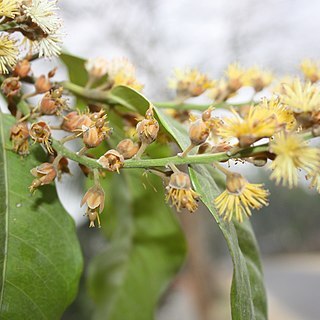Vines 1-15 m, woody. Twigs pale red to pale tan-colored when dry, stout, terete, shortly pubescent, soon glabrescent; internode length unequal, to 5 cm or longer. Petiole (1-)2-3(-5) cm, stout, with bubblelike raised structures, apically with slightly inflated pulvinus; leaf blade elliptic, oblong, or oblong-lanceolate, broadest at middle but sometimes slightly basally or apically, (10-)15-28[-40] × (3.5-)4-10 cm, leathery, both surfaces glabrous, reticulate veins obvious, base cuneate to nearly rounded, apex nearly rounded to ± acuminate and with a 5-12-mm tip. Inflorescences axillary, racemes or sometimes branched or forming panicles, 15-25 cm, at first erect then drooping; axis shortly pubescent to shortly tomentose; bracts linear to ovate, 3-6 mm, trichomes like those on axis. Pedicel 2-4 mm, stout. Receptacle (torus) ca. 3.5 mm in diam., dish-shaped. Sepals (5 or)6, pale yellow, elliptic-oblong, (4-)5-6(-9) × 2-3 mm, erect or spreading, never reflexed, both surfaces densely tomentose, apex acute to obtuse. Androgynophore ca. 2 mm, glabrous; stamens (27-)40 to ca. 80; filaments 4-6(-11) mm, pubescent; anthers 0.5-0.7 mm. Gynophore 7-10 mm, with dense tan pubescence; ovary ellipsoid, 1.7-2.5 mm, glabrous or basally sometimes with trichomes; styles 3(or 4), apex recurved; stigma absent. Fruit orange when mature, ellipsoid, 3-5 × 2.5-4 cm, surface with thin yellow verrucose flecks; endocarp thin, woody; fruiting pedicel plus gynophore 0.7-1.3 cm, ca. 5 mm in diam. Seed ellipsoid, 1.8-2 cm. Fl. Apr-May, fr. Aug-Oct.
More
A vine. It is woody and grows 1-15 m long. The side branches are stout. The branches are speckled. The leaves are broadly sword shaped and 15-28 cm long by 4-10 cm wide. The base is round. The leaves are deep green above and paler underneath with raised white dots. The leaf stalks are 2-3 cm long. The flowers are pale yellow and 5-6 mm long. They have a sweet scent. There are 15-25 flowers in a group. The fruit is fleshy and covered with yellow hairs. It is oblong and 3-5 cm long by 3-4 cm wide. The fruit is yellow and mottled.

